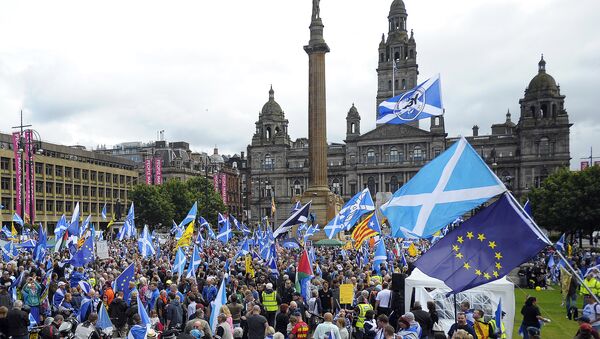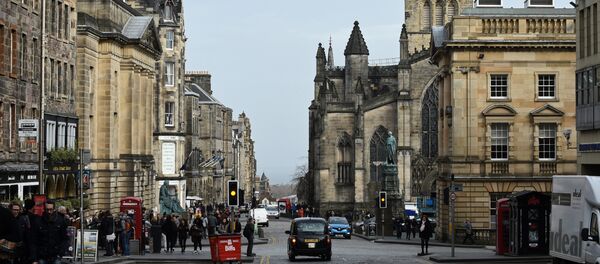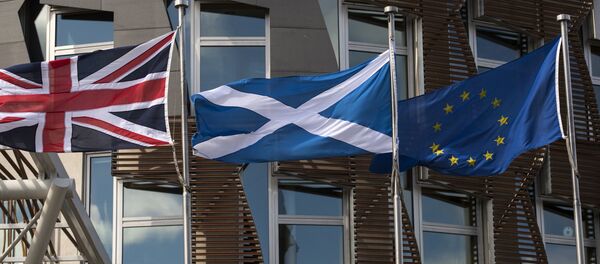The words above constitute the first paragraph of the Strike Bulletin produced by the '40 HOURS MOVEMENT' on February 1st 1919. Exactly 100 years ago today in Glasgow police officers were ordered to draw their batons and launch a ferocious assault on thousands of workers assembled peacefully in George Square in the centre of Glasgow. They had gathered there as part of a strike movement that began four days earlier on January 27th for a shorter working week.
It was a strike organised by a rank and file shop stewards body called the Clyde Workers Committee (CWC) and united engineers, shipyard workers, railway workers and other skilled tradesmen across the city. Initially, a few thousand workers took strike action but by January 31st at least 70,000 had downed tools. The city was at a standstill and the Provost in Glasgow city chambers and the war cabinet in London feared a Bolshevik uprising had begun.
The heading and first paragraph of the '40 HOURS MOVEMENT' Strike Bulletin on February 2nd 1919 was very instructive:
"MACHINE GUNS NO REMEDY
In response to the Clyde Workers' demand for a 40 hours' week, the Government have replied by sending armed troops to Glasgow. Apparently, if the workers do not accept what the employers give them, it is to be rammed down their throats at the point of a bayonet."
READ MORE: Gold Rush in Scotland: Diver Finds Britain's Largest Precious Metal Nugget
It is hard to believe because, like so many radical and anti-Establishment struggles and figures, what happened in Glasgow 100 years ago today is not taught in our schools or analysed in most history books. Glasgow was occupied by armed troops and subjected to three days of martial law. Strike leaders and political activists were arrested from their homes in dawn raids. Socialist newspaper presses were closed down. Six tanks were deployed to the city to aid the troops and machine gun turrets were set up within the city chambers and the old post office building with the barrels of the machine guns pointing into George Square.
It is alleged that the local Maryhill army barracks were locked down for fear soldiers from in and around Glasgow could not be trusted to stay loyal to the government and many of the troops sent to the city were English and arrived in the dark of the night on 31st January.
The truth is the British Establishment mistook a radical strike for a revolution and there is no evidence that the workers strove for anything other than a shorter working week and better working conditions. Yet had the Clyde Workers Committee been bolder in its aims and aspirations it could very well have sparked a revolution in the image of the Bolshevik one which swept the Czars and old social order from power in October 1917 in Russia.
Context is essential to understanding history and any hope that what is recorded in history books and by historians is borne of anything other than bias and subjective opinions is naivety in the extreme. Always remember that history is written by the victors and very rarely if ever reflects well on the vanquished. Mark Twain's wise words should always inform your historical research:
"The very ink with which history is written is merely fluid prejudice"
READ MORE: Analyst Explains Why Social Media Users in Scotland Planning on Boycotting BBC
From 1914 to 1918 the world was at war and the old social order was subjected to severe stress and examination in country after country. The war itself was a grotesque waste of human life with millions of young adolescent men slaughtered like cattle over the desires of kings, queens and rich bosses for greater markets shares and the spoils of wealth and power. Not a single principle was at stake in that war that was supposed to end all wars. Yet at least 10 million military casualties were recorded and 7 million civilian casualties. Up to 6 million others went missing and are presumed dead and millions of others perished prematurely from war-related diseases, illnesses and famines.
In 1915 thousands of workers downed tools in support of the predominantly women-led rent strikes across Govan, Maryhill and other parts of Glasgow. Greedy private landlords saw demand for their properties within the city rocket as workers were demanded in the city. Eager to profit from the increased demand these landlords imposed unreasonable rent increases and then tried to evict any families unable or unwilling to pay.
The women of Glasgow were having none of it. Their husbands and sons were fighting overseas and these greedy property owners sought to throw the women and their children out of their homes. A rent strike was organised and on the day hundreds of women were summoned to appear in court to face eviction orders the shipyards and engineering works in and around Govan were closed down in solidarity action by trade unionised workers. The war cabinet was forced to intervene and the Rent Restriction Act of 1915 was rushed through Parliament. The army of rent striking women, led by Mary Barbour from Govan, won a major battle with the support of the Clydeside workers. That was a harbinger of things to come.
As the war dragged on and the carnage and bloodshed became more widely acknowledged support for the war waned and industrial and political actions became more commonplace across Europe.
READ MORE: Nicola Sturgeon: There Should Be a Brexit Backstop Option for Scotland
Revolutionary agitation against the war underpinned the success of the Bolsheviks led by Lenin and Trotsky in securing the first successful workers' revolution in Russia in October 1917. This was an event which shaped the whole of the 20th Century and inspired millions of workers across the planet.
In November 1918 Germany was in a state of chaos. The Kaiser had been forced to abdicate and a socialist republic was declared. Armed insurrections developed and soldiers mutinied. Lacking an organised and strong socialist party the aspirations of socialists like Karl Liebknecht and Rosa Luxemberg to follow in the footsteps of the Bolsheviks in Russia were eventually crushed in January of 1919 following the Berlin uprising.
Similar armed uprisings, soldier and sailor mutinies and large scale riots spread across Europe engulfing France, Hungary, Italy and England. In fact, war cabinet papers reveal the intention of Churchill to crush the Bolshevik threat in France, Germany and Russia. He was determined to despatch thousands of troops to the new workers' republic in Russia to strangle it at birth through brute force. He was determined to send British troops to join the armies of other countries who surrounded the new socialist republic and tried to invade. Those armies were repelled by the newly formed Red Army which, against all the odds, fought back the invading forces.
This is the essential context to the brutal and bloody treatment of the striking workers in Glasgow on January 31st 1919. At least 70,000 workers were on strike according to contemporaneous newspaper reports but the Strike Bulletin of 30th January 1919 stated that 100,000 were involved and support was growing:
"To The Workers, 100,000 men are on strike in Scotland for the 40 hours week. This number grows daily. That so many men should have responded to the appeal for mass action on their own initiative is striking proof of the strength and virility of the demand for 40 hours. More men are responding every day, and by the end of the week the entire toiling masses in Scotland are expected to withdraw their labour if the Government do not concede the workers' demand".
This was in effect a general strike and a general strike organised by rank and file workers unofficially and not sanctioned or organised by the official trade unions. This was a genuine grassroots workers' movement so no wonder the Government were literally shitting themselves.
READ MORE: 'Shooting a Docile Creature' Should Not be Legal in Scotland — Activist
The CWC had organised a mass meeting on January 29th in St Andrews Hall in Glasgow city centre and it was so packed that four separate overflow meetings had to be held. The workers then marched to Pinkston Power Station and trams were brought to a standstill throughout the city. They ended up in George Square and the Lord Provost of the city received a deputation of the strike leaders, led by Davie Kirkwood and Manny Shinwell. The Provost offered to liaise directly with Prime Minister Lloyd George to ascertain his position in relation to the 40 hour week demand. It was agreed that the strikers should return at 12.30 on January 31st to hear the response of the Prime Minister.
However, the situation in the Square was getting so out of hand that the police chief inspector appealed to Kirkwood to address the crowd to ask them to leave the Square. A Justice of the Peace read the Riot Act giving the police sweeping powers of arrest and detention. The statement was snatched from his hand while he read it. Chaos reigned. A bloody riot threatened to develop.
Kirkwood was allowed onto the first-floor balcony of the City Chambers to address the crowd and his appearance was met with loud cheers. He appealed to the workers to leave the Square and assemble in Glasgow Green. The workers accepted his appeal and proceeded to assemble in the Green 10 minutes from the Square. Fights continued in and around the Square and on the fringes of the Green. Glasgow was in turmoil.
READ MORE: ‘Almost Nothing Is True': Scotland's Sturgeon on UK PM May's Brexit Deal
The next day's Glasgow Herald newspaper, Saturday, February 1st 1919, ran the story under four separate headings:
GLASGOW STREET FIGHTING
The Riot Act Read
STRIKERS AND POLICE IN SERIOUS CONFLICT
LONG LIST OF CASUALTIES
"Unprecedented scenes of violence and bloodshed took place yesterday in Glasgow in connection with the present strike movement".
Were the strikers and the CWC revolutionaries? The answer is no and yes. No in the sense that there was no predetermined plan to cause chaos and seize power through factory occupations and the securing of guns to confront the police and army. But yes in the sense that in an economic system predicated upon the super-exploitation of workers to extract as much profit as possible for private enrichment then even a reformist demand like a shorter working week can become revolutionary. Revolutionary in that it challenges the right of capitalism to demand such unfair working conditions from ordinary workers.
As the Strike Bulletin of 30th January 1919 stated:
"The strike is for a social aim, as the 40-hours' week is meant to benefit all classes of workers. The 40-hours' week will prevent unemployment and maintain the Union rates of wages in all industries. It will enable the men and women coming back to civil life to get jobs which will ensure a decent living in return for their labour. The 40-hours' week means leisure for all and work for all".
READ MORE: Neglect of Scotland in Brexit Talks Opens Door to 2nd Referendum — Solidarity
What a wonderfully progressive and sensible idea and aim. The strike continued into February before an official agreement with the official trade unions around a 47 hour week was agreed. The CWC was side-lined but the truth is without their radical action around the 40-hour week demand the reduction to 47 hours would never have been achieved.
Two final thoughts regarding the historic Forty Hour week strike merit some attention on this centenary day of 31st January 2019.
Firstly although the strike failed to secure the 40-hour week objective it did achieve a significant reduction in the working week and it did further politicise the whole city of Glasgow and much of Scotland. In the subsequent General Election of 1922 Glasgow elected 10 Independent Labour Party (ILP) candidates from the 15 Glasgow constituencies to become MPs. The ILP was avowedly socialist and among those elected to Westminster were strike leaders like Davie Kirkwood and Manny Shinwell both of whom had been arrested and charged in connection with the Bloody Friday riot. This election of 10 radical ILP MPs cemented the idea of greater Glasgow being described as ‘Red Clydeside'.
Secondly how pathetic is it that 100 years to the day after the Bloody Friday Forty Hour Strike riot the average working week in the United Kingdom is over 42 hours a week? (2016 — 42.2 Hrs per week; 2017 — 42.1 Hrs per week: Eurostat — Data Explorer)
READ MORE: From Saddam Hussein to Scotland: Meet the Iraqi Man Who's Been to Hell & Back
But much more importantly quality of life would improve radically. More time for your children, your partner, your parents, your friends, your hobbies, your sports, your relaxation. More time to read, learn and even study formally.
The lasting legacy of the Forty Hour strikers of 1919 is the campaign for a shorter working week must continue until we secure "leisure for all and work for all".
The views and opinions expressed in this article are solely those of the author and do not necessarily reflect those of Sputnik.













